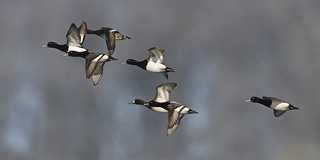Protecting the Boreal Forest
This vast, wetland-rich region contains vitally important habitat for waterfowl and other migratory birds
This vast, wetland-rich region contains vitally important habitat for waterfowl and other migratory birds
By Frederic Reid, Ph.D., and Scott Stephens, Ph.D.
The Boreal Forest is the largest terrestrial biome on the planet. About two thirds of this enormous ecological community is in Scandinavia and Russia. The other third is in northern Canada and Alaska. North America's share of the Boreal Forest is the largest intact forest on the planet, covering 1.6 billion acres. It is a very wet forest; millions of lakes, wetlands, streams, and rivers cover more than 20 percent of the Boreal landscape.
The Boreal Forest provides crucial breeding, staging, and molting habitats for many of North America's waterfowl and other waterbirds. It also holds more than 200 billion tons of carbon, much of it in "cold storage" provided by permafrost and vast peatlands.
When it comes to breeding habitat, the Boreal Forest is the great bird nursery of North America. Some 3 billion to 5 billion birds fly south from the Boreal every fall, including neotropical songbirds, raptors, shorebirds, and cranes. The Western Boreal Forest, which stretches from eastern Manitoba to western Alaska, typically hosts 12 million to 14 million breeding ducks and is especially important to scaup, mallards, American wigeon, American green-winged teal, and scoters. The region is also an important breeding ground for white-fronted geese, small Canada geese, and trumpeter swans.

Photo SCOTT FINK
Wetlands in the Boreal that were once considered remote, stable, and undisturbed are facing increased threats as this resource-rich region is developed. Environmental pressures include forest management, agriculture, hydrologic development, and extraction of oil, gas, and minerals. Fortunately, indigenous leadership is working with progressive industries and conservationists to protect this great wet forest of the North.
Beginning in 2000, DU joined forces with the Pew Charitable Trusts (and later with the William and Flora Hewlett Foundation and the Gordon and Betty Moore Foundation), industries, conservation organizations, and indigenous peoples to help build a framework for Boreal conservation. The framework goal consisted of 50 percent protected lands and 50 percent sustainable development with conservation-minded industries. Ducks Unlimited has also worked with a host of companies operating in the region, including Alberta-Pacific, Mistik, and Weyerhaeuser, to help meet these conservation goals. These industries have principally shifted activities to minimize impacts on water and wetlands.
Indigenous governments and communities in the area have stepped up with strong leadership to establish Indigenous Protected and Conserved Areas, which hold massive stores of carbon and key waterfowl habitats. For example, in Manitoba the Sayisi Dene First Nation is proposing to protect the entire 12-million-acre Seal River watershed, which contains more than 660 million tons of carbon. In the Northwest Territories, the Sahtu Got'ine Dene peoples have proposed the conservation of more than 20 million acres of the Great Bear Lake watershed, which stores some 4.6 billion tons of carbon. Recently, the Edhzhe Indigenous Protected Area was established by Dehcho First Nations and the Canadian government. And the Thaidene Nn Indigenous Protected Area was created by the Akaitcho Dene and Canadian governments. These areas are rich in wetlands important to American wigeon, northern pintails, scoters, and American green-winged teal. Ducks Unlimited is proud to support these conservation efforts and aid land-use planning through remote sensing maps of key habitats.

Boreal wetlands are important breeding habitat for many bird species, including lesser scaup.
Photo GARYKRAMER.NET
Dr. Frederic Reid is DU's director of conservation programs for Boreal and arctic conservation. Dr. Scott Stephens is DU Canada's director of regional operations for the prairies and Boreal.
In July 2019, Ducks Unlimited Canada (DUC) delivered a comprehensive 77-million-acre map of wetlands and other land cover to the Akaitcho Assembly in utsel K'e, Northwest Territories. This represents DUC's largest mapping project, which took almost three years to complete. The final product is a crucial source of ecological and cultural information to support the land-use planning process of the Akaitcho region.
"Mahsi cho [thank you] to DUC for helping us with the land-use plans and wetlands projects. First Nations need help from conservation organizations to assist us in developing our own awareness of the land," says Chief Ernest Betsina, of Yellowknives Dene First Nation (Ndilo).
"The delivery of this information to the Treaty 8 Tribal Corporation and regional communities is a testament to the value of conservation partnerships," says Kevin Smith, national Boreal program manager for DUC. "We are committed to expanding our partnership and relationships with indigenous governments and communities, promoting conservation and protection in their traditional territories, and building bridges for future preservation projects."
Ducks Unlimited uses cookies to enhance your browsing experience, optimize site functionality, analyze traffic, and deliver personalized advertising through third parties. By continuing to use this site, you agree to our use of cookies. View Privacy Policy